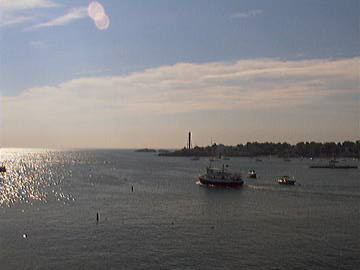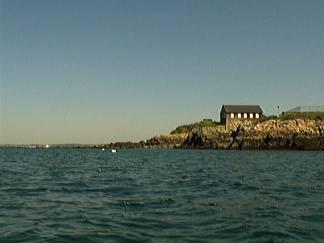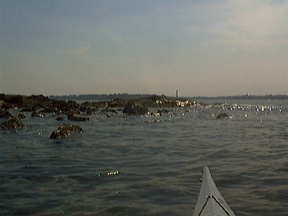
Cat Island
A History of Kings, Captains And Children...
Just Off The Coast Of Marblehead.
by Gail Pike Hercher
photos by Bill Purdin

On Cat Island look out to sea.
| It's just about a mile off the Marblehead, but
in many ways, defined by its past, far farther away than that. Today, it is known as Children's Island and is owned by the Marblehead/Swampscott YMCA, and for the warm summer months is used as a summer camp for children. But it's long and illustrious history, so rich with important events and episodes that helped define the character of the Marblehead itself, lies well beyond the happy yelps of boys and girls enjoying one of New England's most beautiful coastal islands as they while away their summer. In the past it was a pasture, a home for smallpox victims unwelcome on the mainland, and a sanatorium for the mentally ill.  The first person associated with the island was Robert Cotta (also spelled Catta and Cotty), a Salem tailor, who used the land during the The main building of the YMCA camp on the island as it appears today. years of 1635 and 1655 to graze his sheep. The island was named after Mr. Cotta, and through subsequent misspellings and shortenings became known as "Cat" Island, sometimes spelled with two "t's." In 1655, Catta Island was granted to Governor John Endicott in recognition of his service to the King. The island remained in the Endicott family's possession until 1687, when an Endicott descendant sold the island to Richard Reade for 16 pounds. Reade's son, Samuel, who built the first house on the land in 1738, sold the island again to the Wait family of Marblehead in 1761. During the 1730's, over a dozen ships a day entered and clear Marblehead and Salem harbors, trading with the West Indies and many other parts of the world. Unfortunately, along the profits of the shipping industry came the losses caused by a smallpox epidemic. A virulent outbreak in Marblehead in 1773, affected 59 people and killed 14 of them, prompting Captain John Glover, Azor Orne, Jonathan Glover (the Captain's brother), and Elbridge Gerry to suggest that the Town of Marblehead build an inoculation facility. It quickly became apparent to these men that the Town had no interest in the project, so they decided to build a private facility themselves. At that time in history, patients were inoculated with material from human victims of the disease which actually gave the inoculated person a mild case of the disease. ("Cowpox," a mild, contagious skin disease of cattle, usually affecting the udder, that is caused by a virus and characterized by the eruption of a pustular rash and when transmitted to humans, by vaccination, was found to often also convey immunity to smallpox, but this system, was not used until after 1798.) And, because patients were contagious during this inoculation period, they had to be isolated from the rest of the community. Cat Island was an ideal location for such a facility, and the four men bought the island from William Wait for 133 pounds, six shilling, and eight pence, in September of 1773. When "Essex Hospital," as the smallpox facility on the island was named, opened in late 1773, it contained 10 rooms and facilities for a steward, physicians, nurses, and attendants.  each
patient was charged five pounds, 15 shillings for board, nursing,
and inoculation, and one needy person inoculated free for each
patient was charged five pounds, 15 shillings for board, nursing,
and inoculation, and one needy person inoculated free forSign posts along the walking trails on Children's Island. every 10 others. During their four-week stay, Dr. Hall Jackson took care of the patients who, in addition to the inoculation, took as much fresh air as possible. As a result, patients could always be seen walking around the island's 29 acres. The inoculation was risky, but only a few people died at the island facility because of the fine care provided there. Although patients were not allowed to leave the hospital without a certificate stating that they were free of infection, there was considerable Town feeling against returning patients, to the extent that on occasion the hospital sloop was known to have been pushed off and denied land in Marblehead. As hostile feelings increased, Jonathan Glover became very discouraged with the whole thing. After the hospital boat was burned, in one incident, he petitioned the Town to take over the hospital, but his request was denied. Soon after that, the hospital was forced to close down after a marauding band of ruffians set fire to the island buildings. Not only were the proprietors unable to recover their losses (estimated at 2000 pounds), but the two men charged and imprisoned for the crime were set free by the Marblehead Townspeople who threatened to riot if charges were pursued. Peace in Marblehead was restored only when Glover agreed to drop the charges. The four proprietors held onto Cat Island throughout the American Revolution. Early 1776, it is believed that men from the British sloop of war Marlin cut down the trees on the island so that they could get a better view of Marblehead Harbor. Once thickly wooded, the island remains to this day almost entirely clear of trees as a result of the action by that British crew. After the War, the Glover brothers sold their half of Cat Island to Deacon William Williams of the First Church of Christ in Marblehead (now the First Congregational Church, The Old North Church) who then acquired another part, giving him majority ownership. Williams may have intended to use the island as a religious retreat, but after his death in 1787, his widow was forced to sell the island to pay the Deacon's debts. Edward Fettyplace (a 5-term Selectman: 1775, 1776, 1777, 1779, and 1781) bought Williams's share and gradually acquired the rest. In 1848, William Fettyplace, Edward's brother, sold Cat Island to David Blaney of Marblehead for $500. In the same year, the Salem and Lowell Railroad Company was established with the hope of restoring Salem's lost commerce. To build up traffic on the train from the interior mill towns (particularly Lowell), it was decided to build a seaside resort to attract the mill workers. With this in mind, the Salem Steamboat Company was organized in 1851, and the president of the company, Stephen Phillips, bought Cat Island for $1,000. The Company promptly built the Lowell Island House, a hotel with 100 rooms and a dining room that could seat 250. Known as Lowell Island during this period, Cat Island became very popular with the textile workers from Lowell, Haverhill, Bradford, Amesbury, and Lawrence. Round-trip fare and the Salem Steamboat Company boat between Salem and Lowell was about 30¢; the fare from Marblehead to Salem was about 20¢. The boat made five trips daily from Salem and two from Marblehead, although extra runs of trains and steamers were put on during peak periods.Once on the island, visitors were rewarded with good, inexpensive food and music, as well as the use of the bowling alleys, billiard room, small boats, and fishing poles. Since liquor was prohibited at all times, Lowell Island provided a wholesome family atmosphere.  After only six years, the Salem Steamboat Company sold Lowell Island to Gorham L. Pollard of Lowell for $13,000 and he continued to operate the The Hannah leaves Marblehead Harbor at around 7:30 A.M. every day all summer with a boatload of Children's Island campers. Island House Hotel until 1869. During this time the island was sometimes called "Pollard's Island." In 1869, Andrew L. Johnson bought Cat Island from Pollard for $10,000, but under Johnson's management the hotel foundered, so for several years the hotel shifted from one mortgage proprietorship to another until it finally came up for public sale in 1877. Because the highest bid at the auction was only $1,000, the sale was delayed until 1878, when the island was sold to Samuel B. Rindge for $4,500. Rindge, a well-known philanthropist and Marblehead summer resident, presented the property to St. Margaret's (Episcopal) Home of Boston, along with a gift of $1,000 to be used for the purpose of developing a sanitarium for children. As Rindge envisioned it, at Children's Island Sanitarium, no child would be denied treatment because of race, religion, or class. During the next 12 years, through the untiring devotion of the Sisters of St. Margaret and a voluntary medical staff, hundreds of children were cared for. In 1900, however, after a disagreement with the trustees over the admission of adults, the Sisters withdrew their services, and the Children's Island Sanitarium Association was formed to manage the facility. The officers were as follows: President, Phillip L. Saltonstall; Treasurer, John G. Shaw; Secretary, Dr. Joel E. Golthwaite; Visiting Physician, Dr. Herbert J. Hall; and Directors, C. F. Atkinson,  William
Cobb, John Dane, H.C. Haven, Augustus Hemenway, Clement S. Houghton,
Henry Parkman, and F.H. Rindge. Miss Lucy Davis, Superintendent,
was assisted in the care of the children by a corps of volunteers
from Boston who came out for two-week periods. William
Cobb, John Dane, H.C. Haven, Augustus Hemenway, Clement S. Houghton,
Henry Parkman, and F.H. Rindge. Miss Lucy Davis, Superintendent,
was assisted in the care of the children by a corps of volunteers
from Boston who came out for two-week periods.About 270 invalid and crippled children -- chiefly cases of bone tuberculosis, infantile paralysis, malnutrition, rickets, and osteomyelitis -- came to the sanitarium each summer. Ranging in age from two to 13 (10 was the upper limit for boys), they were referred by 15 different agencies including Children's Hospital in Boston and the School for Crippled Children. After the children were brought out courtesy of the Boston & Maine Railroad, the Eustis brothers, of Marblehead, would donate their carriages to transfer the children from the station down to Tucker's Wharf. The most exciting part of the trip, however, was the ride out the island in boatman William Klink's dory, which was replaced in 1869 by the Pelican, a steam launch that could carry 0 children. Captain Klink adored the children and therefore was very careful with them. In all the years he worked for the sanitarium, not a one was harmed during the little voyage out to the island.  Out on the island there were separate quarters for four groups of children: a small house for babies, a ward for 20 incapacitated boys, a The beautiful rocks that surround Children's Island and form perfect snorkling and fishing grounds. similar ward for incapacitated girls, and another building for 45 mobile boys and girls. During the day the children adhered to a rigorous schedule of physical and occupational therapy, and their handicrafts were sold every year at a fair in Boston. All of the little patients were given the sunlight treatment, known in Switzerland as the "cure de soleil." This consisted of exposing children to gradually increasing amounts of sunshine until they could live outdoors virtually nude, which was good for the healing process. Those who were able also took sea baths, while bed bound and cast cases were bathed with salt water. In 1946 the Boston Community Fund withdrew its support of the Children's Island Sanitarium, and the trustees reluctantly returned the island to the Rindge family. For nine years, Cat Island was unused. Then, in 1955 the Marblehead YMCA leased it for a summer day camp program, and the camp was so successful that the following year four "Y" Directors each contributed $3,000 each to purchase the island for the "Y." The YMCA immediately built a new pier and swimming pools, while demolishing the remaining dilapidated buildings, and in the early 1960's the present sailors' lodge and arts and crafts building were built. In 1971, as part of its summer training, the Army Corps of Engineers (Reserve) came to the island to work on the sea wall in order to bury the foundation of the old hospital. Most recently, as a result of the blizzard of 1978, the "Y" qualified for a Small Business Administration (SBA) low interest loan to repair the extensive storm damage. Today, the buildings on the island are in good repair, and the biggest problem is erosion. Hopefully, YMCA officials say, with continued attention and proper plantings, the island will be preserved. Now nearing its 50th Anniversary, the YMCA Children's Island Summer Camp regularly hosts hundreds of young campers during each of the two-week session. Since the late 60's there has been a very popular sailing program including Widgeons, Ospreys, and Rhodes 19s. In the past few years ocean kayaking has become popular with the campers. Campers also participate in archery,swimming, riflery, sports and games, arts and crafts, nature study, fishing, and sea exploration. The thrust has always been on environmental awareness. The "Rangers" Programs has continued for campers interested in adventure, and has enabled the older campers to work as L.I.T.s (Leaders In Training). All of the campers look forward to their overnight stays on the island, although as darkness settles in, campers and visiting parents share a brief worried moment when the boat leaves the campers alone on the island, with their counselors. Many campers at Children's Island Day Camp later become counselors, or otherwise involved with the "Y." Many past presidents, members of the Board of Directors became involved with the YMCA through the summer island experience. Most of the campers come from Marblehead, Salem, and Swampscott; and many are children of former campers. Additionally, each summer there are usually children from other countries in the camp for  whom
Children's Island Day Camp is part of their visit to Marblehead
relatives. whom
Children's Island Day Camp is part of their visit to Marblehead
relatives.Its ownership and future is now secure after a difficult beginning through the years since the Revolution and before. But, Cat Island, now officially renamed Children's Island by the U.S. Government and the City of Salem, over some objections of die-hard Marbleheaders, remains a unique and beautiful place. Just off the coast of Marblehead. Gail Pike Hercher, former Director of Education at the Peabody Essex Museum in Salem, is a local historian, regular contributor to Marblehead Magazine, and well-known author of the book, Victorian Marblehead. Bibliography Richard W. Searle, "History of Catta Island," in the Essex Institute Historical Collections, Volume LXXXIII, October, 1947, provided much of the information on the early history of the island. J. Daryl Gallant, current and long-time Director of the Marblehead/Swampscott YMCA, his staff, along with Fred Orne, were very helpful in compiling facts about the island since 1947. |